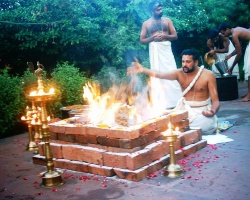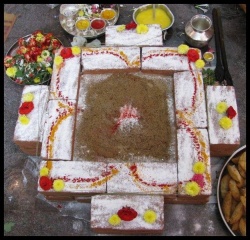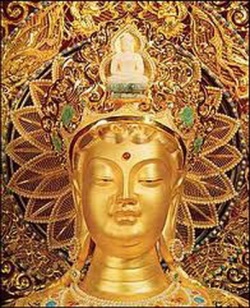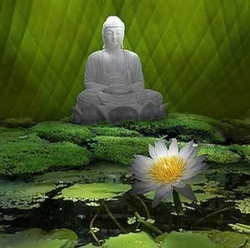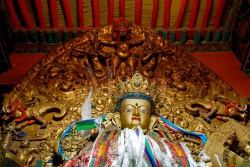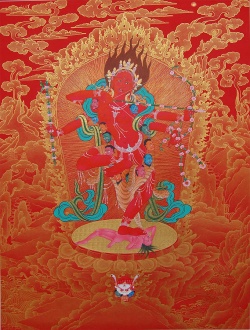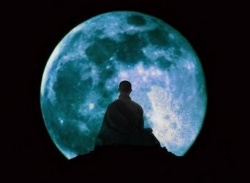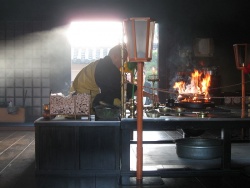Homa (ritual)
Homa (also known as homam or havan) is a Sanskrit word (Sanskrit: हवन) which refers to any ritual in which making offerings into a consecrated fire is the primary action. Its practice by "Rishis" in ancient time refers close to the Vedic era. At present, the words homa/homam and havan are interchangeable with the word Yajna.
Homas are an important religious practice in Hinduism where they are part of most Sanskar ceremonies. They are also prevalent in current-day Buddhism (particularly the Tibetan and Japanese Vajrayana traditions) and Jainism.
==Procedure==
Although a consecrated fire is the central element of every homa ritual, the procedure and items offered to the fire vary by what occasions the ceremony, or by the benefit expected from the ritual. Procedures invariably involve -
the kindling and consecration of the sacrificial fire;
the invocation of one or more divinities; and,
the making of offerings (whether real or visualized) to them with the fire as via media, amid the recitation of prescribed prayers and mantras.
The consecrated fire forms the focus of devotions; it is often maintained on specific types of dung, wood, dried coconut (copra) and/or other combustibles. The fire-altar (vedi or homa/havan kunda) is generally made of brick or stone or a copper vessel, and is almost always built specifically for the occasion, being dismantled immediately afterwards. This fire-altar is invariably built in square shape. While very large vedis are occasionally built for major public homas, the usual altar may be as small as 1 x 1 foot square and rarely exceeds 3 x 3 feet square. Again, whereas major altars at public events may include a hollowing of the earth to create a relatively deep pit, usual altars involve no such excavation and indeed rise only inches above the ground.
In all events, the arrangement is centered in the middle of a space, which may be either outdoors or indoors. The principal people performing the ceremony and the priests who instruct them through the rituals seat themselves around the altar, while family, friends and other devotees form a larger ring around that center. The length and procedure of a homa depends on the purpose to which it is performed; many different types of homas exist, and the following list is only illustrative.
==Some common Homas==
Homa rituals have been performed by Vedic priesthood|Vedic priests for several millennia. The following is an illustrative list of a few such homa rituals:
| Ceremony | Purpose | |
| Aayushya homa | to ward off evil influences present in a child's life immediately following its birth, thereby ensuring longevity | |
| Mrutyunjaya homa | for ward off life threatening situations like accidents and ensure longetivity of life | |
| Dhanavantri homa | for good health | |
| Durga homa | to cancel negative energies; for self-confidence | |
| Chandi homa | For Victory in all endeavors | |
| Gayatri homa | to facilitate positive thinking and subsequently performing good karma | |
| Kritya Pariharana | to counter the effects of black magic | |
| Ganapati homa | to overcome obstacles | |
| Lakshmi Kubera homa | for wealth and material prosperity Thila homam performed for warding of the evil effects of departed soul.It is performed only once in life time preferably at Rameswaram/ Thrupullani( sethu karai) | |
| Mangala Samskarana homa | to celebrate auspicious events; to attain Moksha | |
| Mahadevi homa | for the stimulation of a marriage and for marital felicity among those already married | |
| Navagraha homa | to appease the Nine planets and limit the evil influences in one's horoscope | |
| Punyahavachana homa | for the naming of a child | |
| Sudarshana homa | for success in an undertaking | |
| Santhana Gopala homa | for blessings for a Child | |
| Rudra homa | Getting rid of all negative influences | |
| Vastu homa | Vastu (energy in buildings) | |
| Vidya homa | to benefit students; to facilitate learning | |
| Vishwa Shanthi homa | for universal peace and harmony, as also harmony between the self and the universe | |
| Viraja Homa | purification rites performed as part of the formal ceremonies by which a person takes the vows of renunciation (Sannyas), thereby becoming a Sanyasa|Sanyasi (monk) |
The purification rites of the Viraja homa ritual also apply to the formal ceremonies by which a Hindu monk takes up the vows of renunciation (Sannyas), thereby becoming a Sanyasa|Sanyasi. The procedure is a part of the full Sannyas Diksha monastic initiation ceremony. After the Homa, the monk receives the ochre robes the characteristic dress of Hindu monks, from his teacher (guru).
==In Japanese Esoteric Buddhism==
Shingon Buddhist monks often perform homa in the morning with offerings of wood prayers.
The Homa (護摩, goma) Ritual of consecrated fire is unique to Vajrayana and Esoteric Buddhism and is perhaps also the most mystical and cognitively powerful. It stems from the Vedic Agnihotra Ritual and is performed by qualified priests and acharyas for the benefit of individuals, the state or all sentient beings in general. The consecrated fire is believed to have a powerful cleansing effect spiritually and psychologically. The central deity invoked in this ritual is usually Acalanatha (Fudō Myōō 不動明王, lit. immovable wisdom king). The ritual is performed for the purpose of destroying negative energies, detrimental thoughts and desires, and for the making of secular requests and blessings; these are in the form of pieces of lumber with prayers written down by individuals and stamped with Acalanatha's seed syllable.
In most Shingon temples, this ritual is performed daily in the morning or the afternoon, and is a requirement for all acharyas to learn this ritual upon entering the priesthood. Larger scale ceremonies often include the constant beating of taiko drums and mass chanting of the mantra of Acalanatha by priests and lay practitioners. Flames can sometimes reach a few meters high. The combination of the ritual's visuals and sounds can be trance-inducing and make for a profound experience.
HOMA (Goma, jap)
Homa is the “Fire” ritual meditation. Originating in ancient India, it was later appropriated to Buddhist use. Homa means the burning of darkness and the term gives the image of an upsurging flame. By this ritual, we may burn up those Karmic defilements, which still remain within us. It is the “fire of the Wisdom of the Buddha” which destroys all worldly passions. There is the “Outer” Homa, which is the actual fire kindled in the ritual, and the “Inner” Homa, that is
the fire of the Wisdom of the Buddha which we have kindled within our minds. There are five different stages in the ritual differing according to the particular Deities involved. It is written in the Yoga ritual book about the Inner Fire as follows: “When the hand creates the Buddha's Mudra, it increases the power of sacred prayer flags and banners. It subdues the anger of Deity Vajrapani, who then will accept our invitation. One should have respect and love for the Lotus Scripture.
In executing this ritual, all five Yoga meditation methods should be used”. The Outer Homa is offered to Buddha and Bodhisattva to enhance the power of the Dharani and to bring about faster results. One must have a heart of perfection as the basic motivating force. The book of rituals on Homa said: “Focus and meditate on the word “A”, imagine yourself being surrounded by fire, which is burning off all the bad karmas, and see the woods – your ignorance - being burned off leaving nothing behind. The clear holy water will flow and refresh all ten directions of the world, and it will help grow the seeds of wisdom, and the 'seedsyllable' will be born. This is the Body of Law, the secret of internal ritual of Homa. “
In fact, the Outer Homa ritual only has the effect of eliminating sins and producing blessings in this samsara (world of life and death) while the Inner Homa has the effect of eliminating worries that cause rebirth. If the Shingon practitioner does not understand this concept and only practices the Outer Homa, he will just be a common fire worshipper. In summary, Secret Buddhism worships The Body of Law above all Buddhas and Bodhisattvas. The organization of the Secret school has different levels and different names. However, the secret magic arts are always kept behind doors, hidden to the general public.
It is the secret rules transmitted verbally from the master to his disciple. It is the tradition to keep the sacred laws secret. In the past, when a master wanted to pass on the secret doctrine, he must observe among his disciples to choose the one best qualified, one who has more virtue than karma, one who has totally devoted to achieving liberation and detachment from the world. The master would then hand down the precious teaching to help that person achieve his goal.
It is similar to throwing jewels into the river if the doctrine is given to the wrong person. If the practitioner receives the secret doctrine while his karma is still heavy, or if his heart is still attached to worldly pleasures, or if he is not fully committed to the Path of Enlightenment, it would not be useful for him, and he may damage it. Even when the teachings are exposed, it would be difficult for anyone to understand its full meaning due to the complexity of the rituals. That is why it is called Secret Buddhism, also called True Words, because it represents the path of the original word. The word is not spoken using common language; it is spoken through a Mantra (sacred speech), a Yantra (sacred seal), a Mandala (sacred Altar), and through Maithuna (Love).
